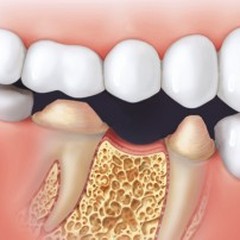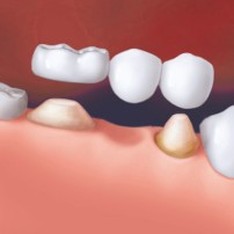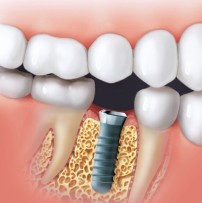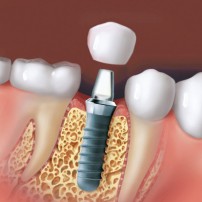Restoring missing teeth
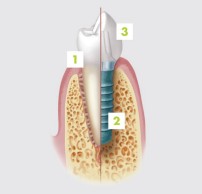 1.Natural tooth 2. Implant 3. Crown
1.Natural tooth 2. Implant 3. Crown
Missing teeth may be caused by accidents, cavities or periodontitis.
There are 3 basic approaches to the situation:
Which approach is more appropriate is dependent on a wide range of factors but generally:
There are 3 basic approaches to the situation:
- Leave the space left by the tooth empty
- Orthodontically move other teeth into the space to 'replace' it
- Place an artificial replacement in the space to 'restore' the lost tooth
Which approach is more appropriate is dependent on a wide range of factors but generally:
- Spaces at the front of the mouth (visible in the smile) should be restored/closed for aesthetic reasons
- Spaces left by molars should be closed/restored for functional reasons as most chewing is done here and the teeth provide a definitive 'biting stop' that protects the front teeth.
- Spaces in the far back of the mouth (like the space left by the wisdom tooth when it is removed) usually do not need to be closed/restored
- The patient's level of confidence in talking, smiling and eating is also a factor.
|
When considering whether to restore/close a space, the following factors are important to me:
|
|
What are the factors that affect my decision on what sort of restoration to place?
What options are there to restore missing teeth? |
|
Advantages(compared to conventional bridges)
Disadvantages
|
- I would recommend these devices only for front teeth in patients who:
- have ready, fast access to a dentist (in case the bridge falls out)
- do not usually face socially demanding situations very often
- front teeth that (ideally) do not touch or touch only very lightly
Implants
An implant is a device made of titanium that, as the name suggests, is implanted into the jaw bone. The titanium osseointegrates with the jaw bone. This means that during healing, after an implant is placed, the cells of the bone will attach themselves to the surface of the titanium, and form bone attached to the surface of the implant. At the moment, titanium is the only material we know that exhibits this property. The new artificial tooth is constructed over the screws.
Dental implants though is costly can help improve patient's ability to eat, speak, looks and confidence.
Mini implants
These implants are smaller in diameter than regular implants (typically 1.5-3mm as compared to 3.5-7mm). To compensate for their small diameter, they are sometimes longer.
An implant is a device made of titanium that, as the name suggests, is implanted into the jaw bone. The titanium osseointegrates with the jaw bone. This means that during healing, after an implant is placed, the cells of the bone will attach themselves to the surface of the titanium, and form bone attached to the surface of the implant. At the moment, titanium is the only material we know that exhibits this property. The new artificial tooth is constructed over the screws.
Dental implants though is costly can help improve patient's ability to eat, speak, looks and confidence.
Mini implants
These implants are smaller in diameter than regular implants (typically 1.5-3mm as compared to 3.5-7mm). To compensate for their small diameter, they are sometimes longer.
Dentures
A denture is a removable device, and is generally the cheapest method of replacing a missing tooth. There are a lot of design variations, but dentures can be classified by the predominant material used in their construction:
1) Chrome cobalt (the 'metal based' denture)
2) Acrylic resin (the classical plastic denture)
3) Flexible resin (often referred to as flexible dentures)
Advantages
Disadvantages
Flexible dentures
These devices are very useful for patients who want dentures but who might have problems like:
Disadvantages
A denture is a removable device, and is generally the cheapest method of replacing a missing tooth. There are a lot of design variations, but dentures can be classified by the predominant material used in their construction:
1) Chrome cobalt (the 'metal based' denture)
2) Acrylic resin (the classical plastic denture)
3) Flexible resin (often referred to as flexible dentures)
Advantages
- Generally very low cost
- No surgical procedure required
Disadvantages
- Biting forces that can be applied are very low compared to natural teeth and the other treatment options
- Not very durable
- Socially troublesome - can move around or come loose
- Detrimental effect on remaining teeth and gums
- Palatal plates are less comfortable and more difficult to adapt to than other alternatives
Flexible dentures
These devices are very useful for patients who want dentures but who might have problems like:
- Discomfort when biting using a normal rigid denture
- If a normal denture cannot be secured properly
Disadvantages
- The biting forces you can exert with these dentures is even less than that of the normal denture
- Generally wears out faster than the regular acrylic denture
- More costly than a regular acrylic denture
Leaving a missing tooth unrestored
if you have a tooth removed and do not replace the missing tooth you have de facto taken the option of leaving the extracted tooth unreplaced. This can lead to the following problems :
tilting and movement of the adjacent teeth
All our teeth are connected by collagen fibres in the gum. These exert a (very small) pulling force that keep the teeth together. This force counteracts the (also very small) amount of wear that occurs as adjacent teeth rub against each other. However when a tooth is missing this force will tend to pull the neighboring teeth towards each other. They will therefore tend to tilt in to the space.
supraeruption of the opposing tooth
This is generally only a problem when you extract teeth from the lower jaw. All our teeth have a tendency to continue erupting (slightly) throughout life. This effect helps to counteract the wear and attrition of our teeth through continued usage. However when a tooth in the lower jaw is lost this effect will cause the upper tooth to overerupt. This, in addition to looking rather unsightly, reduces the space available should you choose to restore the missing tooth at a later date. It can proceed until the upper tooth is actually biting on the lower gum which can be painful.
increased chewing and bite load on the remaining teeth
Each molar absorbs about 15% and each premolar about 10% of our chewing and clenching force when all the teeth are intact. As teeth are lost the remaining teeth are forced to absorb a corresponding higher load. This becomes more significant when more teeth are lost. Our front teeth, because of their shape and position, are unsuitable for taking the clenching load on their own.
Despite these problems and potential complications there are a few situations where leaving a missing tooth unrestored is the most appropriate approach. The most clear cut situation is a wisdom tooth or second molar that is very difficult to clean or a tooth that is crowded out of the dental arch (in fact it might be advisable to remove such a tooth preemptively if it interferes with proper hygiene). In most other situations leaving the space unrestored is usually a compromise solution due to cost or other considerations and is not considered optimal.
if you have a tooth removed and do not replace the missing tooth you have de facto taken the option of leaving the extracted tooth unreplaced. This can lead to the following problems :
tilting and movement of the adjacent teeth
All our teeth are connected by collagen fibres in the gum. These exert a (very small) pulling force that keep the teeth together. This force counteracts the (also very small) amount of wear that occurs as adjacent teeth rub against each other. However when a tooth is missing this force will tend to pull the neighboring teeth towards each other. They will therefore tend to tilt in to the space.
supraeruption of the opposing tooth
This is generally only a problem when you extract teeth from the lower jaw. All our teeth have a tendency to continue erupting (slightly) throughout life. This effect helps to counteract the wear and attrition of our teeth through continued usage. However when a tooth in the lower jaw is lost this effect will cause the upper tooth to overerupt. This, in addition to looking rather unsightly, reduces the space available should you choose to restore the missing tooth at a later date. It can proceed until the upper tooth is actually biting on the lower gum which can be painful.
increased chewing and bite load on the remaining teeth
Each molar absorbs about 15% and each premolar about 10% of our chewing and clenching force when all the teeth are intact. As teeth are lost the remaining teeth are forced to absorb a corresponding higher load. This becomes more significant when more teeth are lost. Our front teeth, because of their shape and position, are unsuitable for taking the clenching load on their own.
Despite these problems and potential complications there are a few situations where leaving a missing tooth unrestored is the most appropriate approach. The most clear cut situation is a wisdom tooth or second molar that is very difficult to clean or a tooth that is crowded out of the dental arch (in fact it might be advisable to remove such a tooth preemptively if it interferes with proper hygiene). In most other situations leaving the space unrestored is usually a compromise solution due to cost or other considerations and is not considered optimal.


